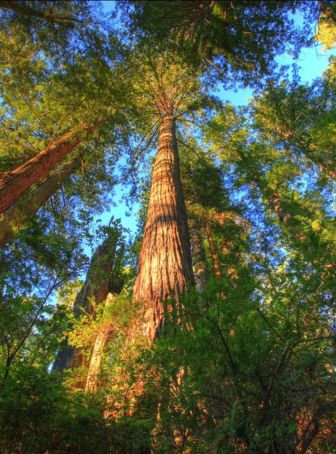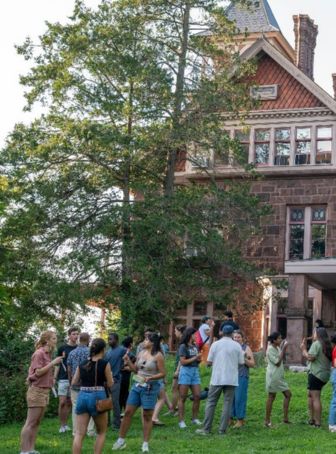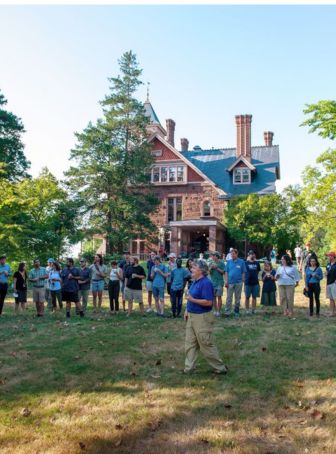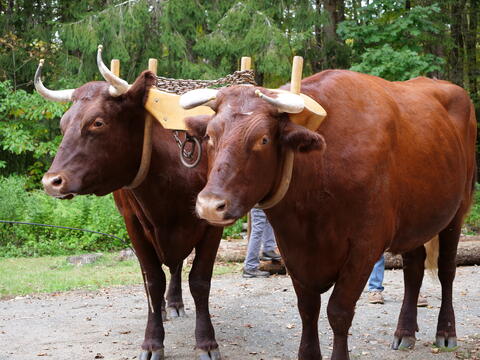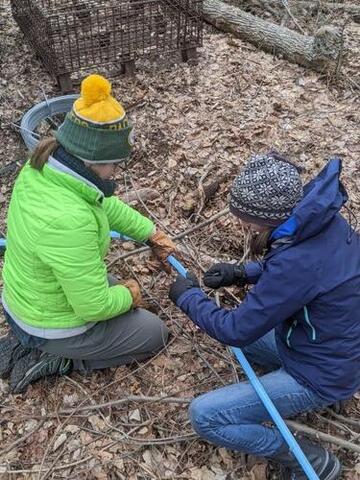
By Isaac Merson ’23 MEM
“There is a forest in every one of us,” Professor of Silviculture and Forest Ecology Mark Ashton explains as we meander through the powerful oaks, graceful maples, and stout hickories of the Yale-Myers Forest, where he serves as director. We breathe in the forest with every breath. But sweeter than oxygen, and even more delicious to consume, is the sugar from the maple tree. This year, for the first time in over 100 years, maple syrup was produced at YMF.
In early March, crystal snow coats the ground. The 7,840-acre Yale-Myers Forest stands empty and expansive, leaves have long since fallen and the branches hang bare. Cool dark water steps down the slopes of a forest stream, eddying beneath a thin layer of ice. Within the tips of every maple branch, tiny buds are waiting, hungry for warmth, hungry to grow. Tiny cells called photoreceptors are attuned to the changing pattern of light that marks the seasons. Like an orchestra before the first note, the forest waits, poised and attentive. The buds are listening for the right temperature and light, the sustained wavelengths of spring.

The recently constructed sugarhouse sits in a leafless winter Yale-Myers Forest as stewards set up blue tubes and taps. Photo by Isaac Merson ’23 MEM.
When the buds receive their cue, the long winter dormancy ends, the tree springs into action. Sugar from previous years is stored away in the branches, stems, and roots. As the sun rises and the days begin to warm, frozen gas in the sap warms too and then expands; sugar is sent toward the leaves once they are out and evapotranspiration begins. This spring flow of sugar is ephemeral, waiting for the leaves to appear to give them the kick of sugar they need to begin their lives as the photosynthetic factories of the tree.
The tree is making an investment: once the leaves emerge, they will make sugars of their own and send the surplus back down into the roots and wood. Maple sugaring exists only in that brief window of spring, just three or four weeks, as starches in the tree are converted into sugars in anticipation of the upcoming growing season. All of the living transport tissue of the tree – the xylem and the phloem – is recruited into sugar flow in a mighty upward rush of sweetness.
In her seminal text Braiding Sweetgrass, Robin Wall Kimmerer traces this process and the language of reciprocity and exchange it helped inscribe for the tribes and nations Indigenous to the eastern woodlands. For hundreds of generations, Indigenous peoples of North America have harvested the sweet sap of the maple and boiled it down to make granulate maple sugar. In northeast Connecticut, where Yale-Myers Forest is located, it is the Nipmuc Nation who have traditionally stewarded the land and harvested the sugar that flows up through the maples each spring. Many of the people who have lived off this land have relied upon maple and made it a part of their culture and values. Maple sap flows when the nights get down below freezing and the days rise above. The freeze and thaw of the sap drives an increase of pressure in the tree during the day, which is finally released through the tapholes.
Maple syrup is a marvel: thick and rich, dark and bone-shuddering sweet. Close your eyes and see if you can conjure the taste, mahogany and amber, sunlight and woodsmoke.
Ask Joseph Orefice, and he’ll tell you maple sugar is the best sugar there is. Orefice must float down rivers of syrup in his dreams, spinning down a maple river with a pancake float beneath him. “Everything about maple is good,” he explains. “It’s the best sugar.” Dark haired and good-humored, Orefice is the director of forest and agricultural operations of Yale Forests and a 2009 Master of Forestry alum with a love for Yale-Myers Forest. He speaks like he’s waiting to move, action and excitement glinting in his eyes.
Orefice sees a future where maple syrup can compete with beet sugar and sugar cane and provide a climate-resilient sugar that doesn’t rely on high intensity annual inputs like pesticides, fertilizers, or tractors. Maple sap can be harvested year after year, while supporting a diversity of wildlife and other plants and while sequestering carbon on the same lands where the sugar is harvested. But right now, Connecticut only produces less than half of one percent of its maple sugar potential. Orefice wants to change that and to help connect Yale University to its forests through the joy of maple syrup. “I would love to have maple syrup sales supplement the stewardship of Yale-Myers Forest,” Orefice explains. “So that people realize the value of Yale Forests and the value of maple syrup.”
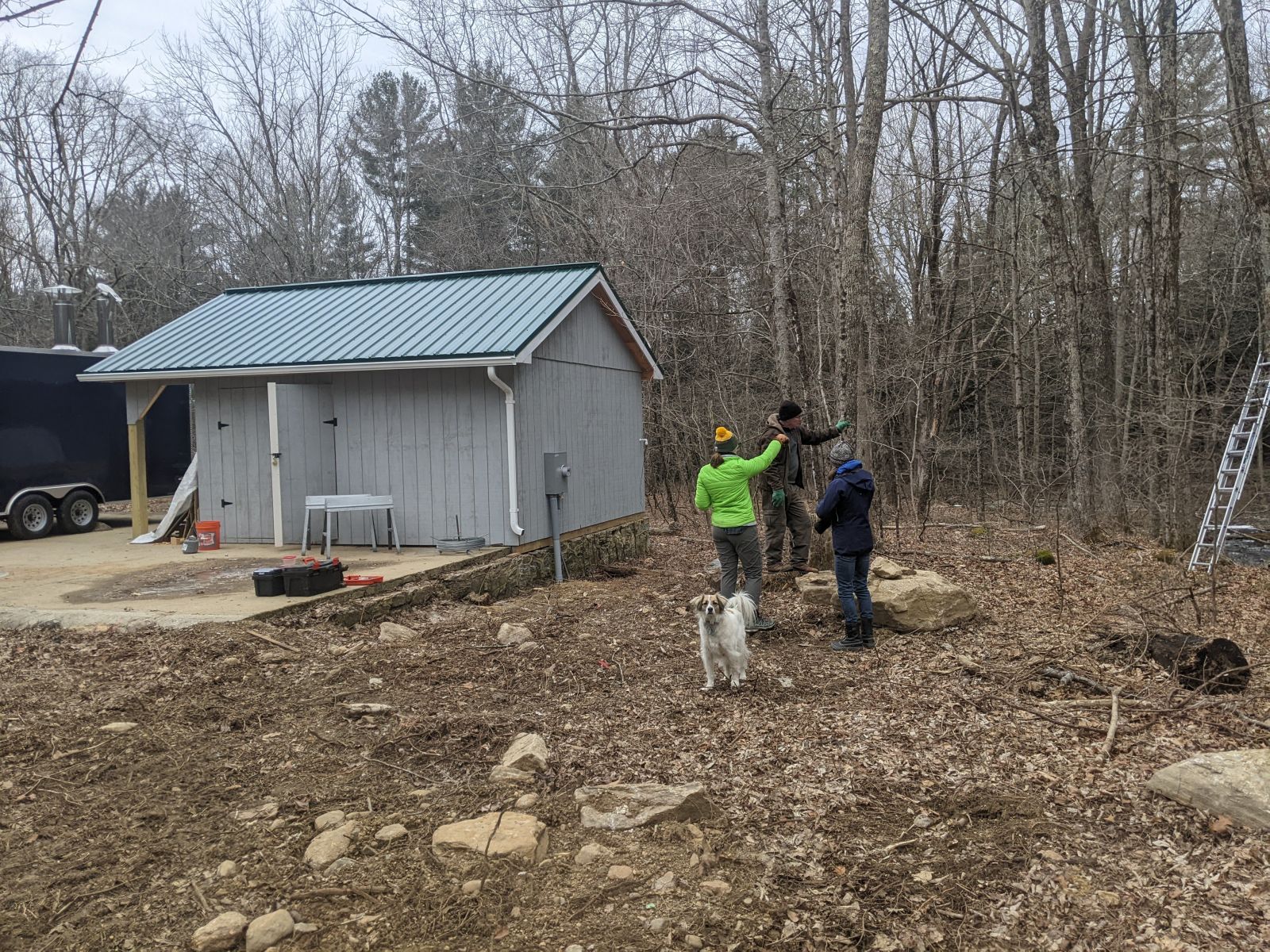
Mary Katherine DeWane ’23 MF and Emma Broderick ’23 MF/MBA work alongside YMF Caretaker Steve Prinn and his forestry dog Banksy to create the tapping network. Photo by Isaac Merson ’23 MEM.
In 2020, Orefice was able to work with the local maple producers organization in the northeast corner of Connecticut to secure a USDA Acer Access Program grant of $390,000 to bring a maple education, outreach, and extension program to the Yale-Myers Forest. The program needed a working sugarbush to use as a demonstration. That’s where the students came in this year. The Forest School students Mary Katherine DeWane ’23 MF, Emma Broderick ’23 MF/MBA, and Hannah Andrew ’22 MF/JD were hired as maple managers this fall. Broderick and DeWane joined forest caretaker Steve Prinn in setting up taps on 109 sugar and red maples over the course of the long winter. Each of those taps could draw as much as 1.5 gallons of sap on a good run of spring weather. With the help of Orefice, they erected a sap storage facility and outfitted a mobile sugarhouse with a new high efficiency evaporator and reverses osmosis machine.
“Maple takes time,” Orefice explains. The sap is mostly water, and to make concentrated sugar has historically meant waiting for a long, long time. Traditionally, wood fires were used by Indigenous peoples and then by early settlers to slowly boil down the sap. It takes 44 gallons of sap to make 1 gallon of maple syrup. I remember my mother boiling sap on cold Maine winter nights, staying up half the night to wander into the kitchen to little by little add more sap to a large silver pot. With the new program at YMF, they’re using ingenuity and research-driven methods to make the process more efficient and climate friendly.
On one early March day, with the snow still on the ground, I went to visit the forest to see how they planned to make a new maple center in the Quiet Corner of Connecticut. Maple taps connected to vacuum tubes sucked the sap downhill as the spring music began to play in the sapwood of the trees. This gentle pressure helps to mitigate the slower flows of sap which can accompany the changing climate, where nights are warmer and the difference between day and night isn’t as great.
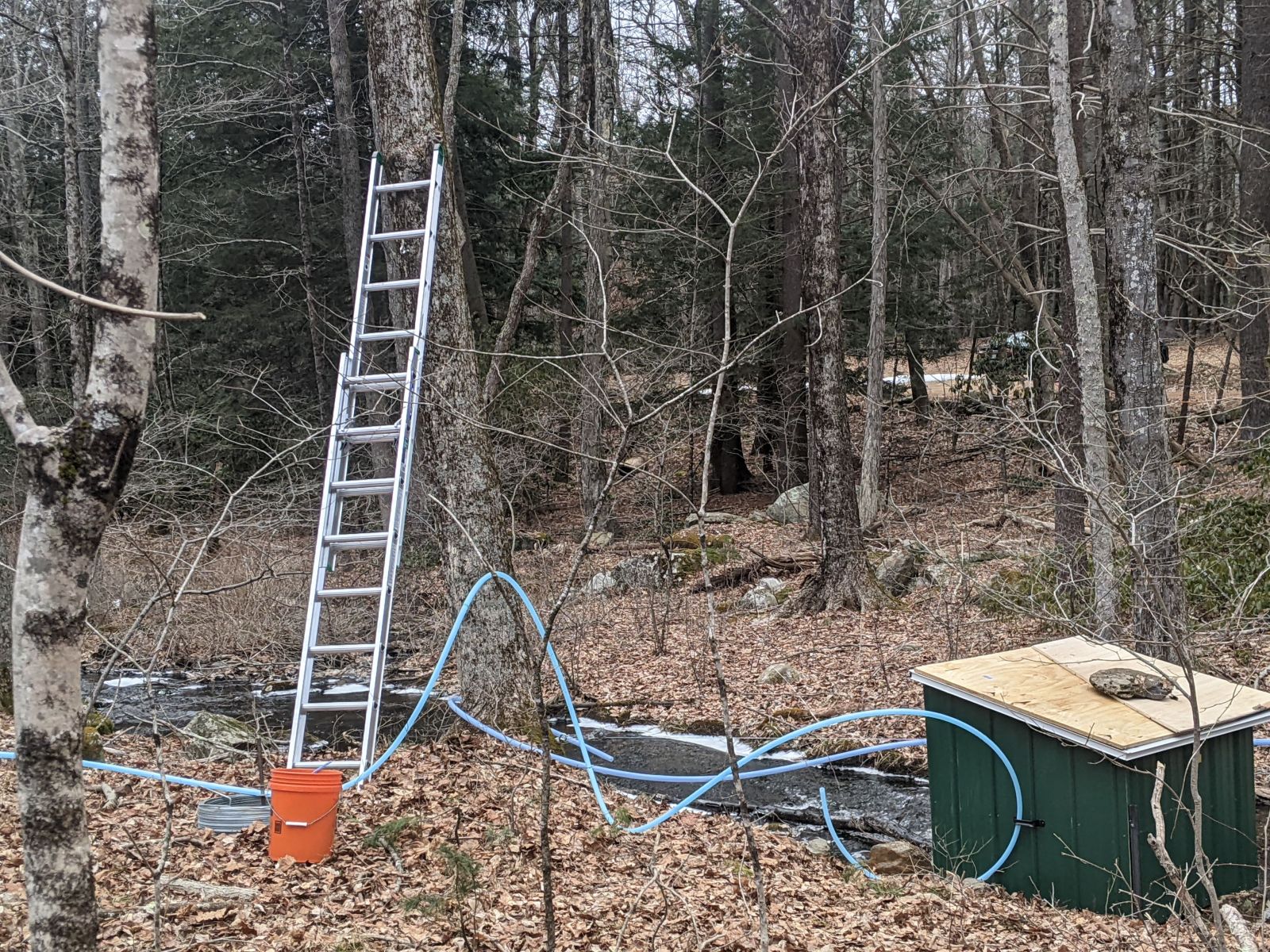
Yale-Myers Forest looks different this winter as blue tubing crisscrosses the landscape to send fresh sap to the sugarhouse to be converted to maple sugar. Photo by Isaac Merson ’23 MEM.
The blue tubes spiderweb through the trees, supported on high tensile wire, carrying sap drop by drop towards the sugarhouse. DeWane and Broderick told me they tied over 2,000 wire twist ties to connect the fractal network of tubes. They spent over 100 hours in the forest, learning to look up at the branches splitting symmetrically high above to identify the maple trees, to look for the dark brown and seafoam green lichens on a slightly shaggy trunk. “At first it took a lot of time,” said DeWane as she showed me which trees surrounding us were maples. “Now I just look up and I’ve got it.” She said, “it’s about showing up and putting in the work, one small step at a time.”
Orefice says, “They’re both such hard workers, we wouldn’t have got it done without them.” This is a different kind of work, in connection with the land. Broderick told me about looking up to watch birds flitting through the trees. Prinn and Orefice told me they had tapped trees with their families as children and have been called back to it ever since.
It is a heritage and a way of making sugar that allows the next generation to tap the same tree 100 years later, thumbing the scars of tapholes long since healed over.
But even with the long history of sugaring, there is more to learn. And that is the goal of the Yale Forests’ Maple Education and Extension Program, which has already begun giving workshops and demonstrations to between 40 and 70 nearby neighbors and sugar producers as part of The Forest School’s Quiet Corner Initiative for land management and community building. The first step to sustainable sugar is to practice sustainable silviculture, growing healthier trees that produce more sap, with some trees thinned out to give the maples more room to grow.
But once the trees are tapped and tubed, there’s still a long way to go before the finished syrup. Orefice explained the innovations which might make the process a bit easier: Before the sap reaches the boiler, it is passed through a space age reverse-osmosis machine.
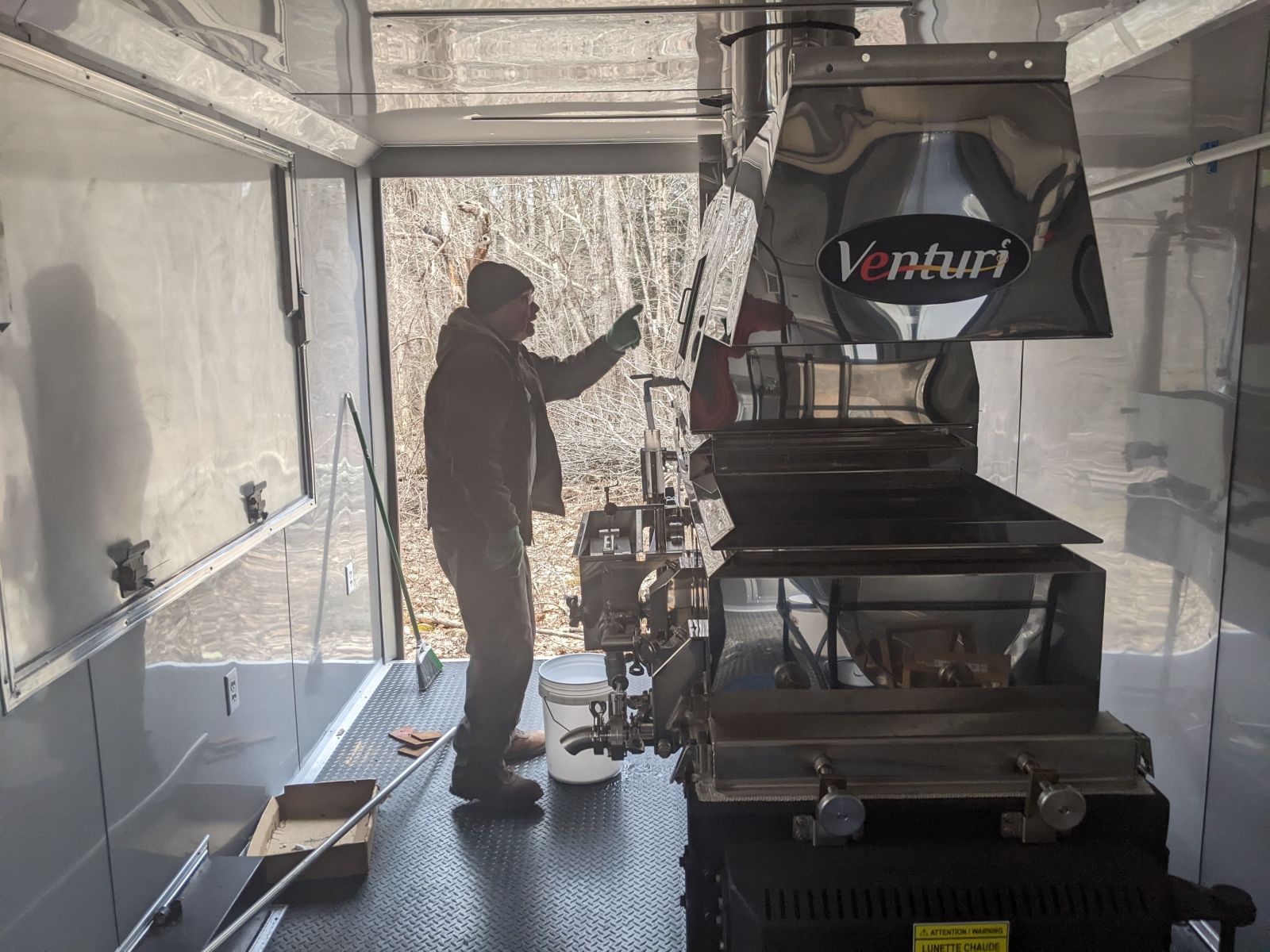
Caretaker Steve Prinn checks on the efficient wood burning evaporator as the first batches of maple syrup are on their way through the production line. Photo by Isaac Merson ’23 MEM.
In the reverse osmosis machine, sap is pressurized and runs through a chamber divided by a thin membrane, which only water molecules can pass through. With the sap pressurized by an electric pump, most of the water seeps through the membrane into a tank of pure water on the other side. The pure water is used for cleaning equipment, while the concentrated sap heads to the evaporator. Orefice tells me that this simple process can remove as much as 80% of the water in the sap, with very little energy required. Local maple producers are excited; everyone wants to peek at the gadget and learn how it’s used.
At Yale-Myers, Hannah Andrew has been the jack-of-all trades in charge of boiling down the concentrated sap into the more than 20 gallons of syrup produced in the first year. Firewood comes from oaks and pines, cut so the maples had more room to grow. Little is wasted. Syrup is poured out from the evaporator, filtered, and then into the familiar glass maple syrup bottles. Starting in 2023, it will be labeled and sold in within Yale, so the university can connect to its forests and support them. Each year more trees could be tapped; Orefice tells me there’s no shortage of demand for Yale Forests’ maple syrup. Maple syrup has the potential to replace a significant portion of the sugar used today if given the chance, with only the trees already growing in the ground. But it will take a new generation of maple sugar producers, and an intergenerational sharing of knowledge. Knowledge like the sugar in the tree, flowing both ways.
Steve Prinn is 67, he taps 160 trees of his own on his land just up the road. He told me being out on the land, learning from students and teaching them too is his dream retirement. He loves that each time students come to visit, he learns a new plant or mushroom, and also gets to pass on some of his knowledge of how to steward the land. He was patient and curious with an easy smile and his dog ran through the trees and leapt across the cold clear brook. The laughing song of a nuthatch echoed through the trees; green moss curled between the silver roots.
As Prinn was climbing into his truck to drive home, I called after him, “Can you describe the way that maple sugaring makes you feel?”
He laughed, thought for a moment, and then smiled.
“Sore and tired.”
Orefice agreed. Maple days are long and working a boiler can be hot and uncomfortable. But Orefice added that one of his favorite things about the work is that when you finally get to wash off at the end of the day, the scent that rises off your clothes is maple, sweet and pure. One last gift from the maple trees.
